Maine is one of the best states to visit if you’re looking to view wildlife. This lovely small state offers many boat tours, which can take you up and close and personal with whales. Many whale species swim through Maine, including killer whales. So, what are the types of whales you’ll find in Maine? When is the best time to see these amazing aquatic animals?
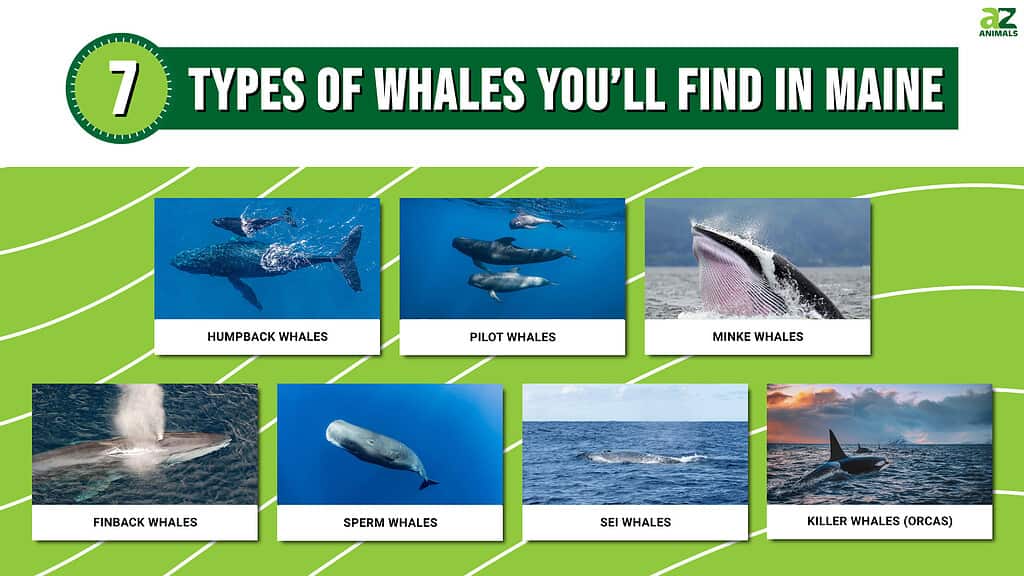
1. Humpback Whales
The first whale on our list is the humpback whale. This large and impressive creature is very common in Maine. It’s one of the best states to view them. Humpback whales use the Gulf of Maine as a feeding ground. Although there is no guarantee you’ll see a humpback whale on your next visit, they are most abundant in mid-April through October.
Humpback whales are large baleen whales. They are about 46 to 56 feet long. This whale species is easy to distinguish from other whales. For instance, humpback whales have long pectoral fins and tubercles on its head. Humpback whales swim far. In one year, they can cover up to 9,900 miles. Although humpback whales were once nearly extinct, they are now listed as Least Concern on the IUCN Red List. During the 1960s, there were only about 5,000 humpback whales in the wild. People travel from all over the world to get a chance of seeing a humpback whale breech, which is when they ascend to the surface for air. This impressive leap is a sight to see.
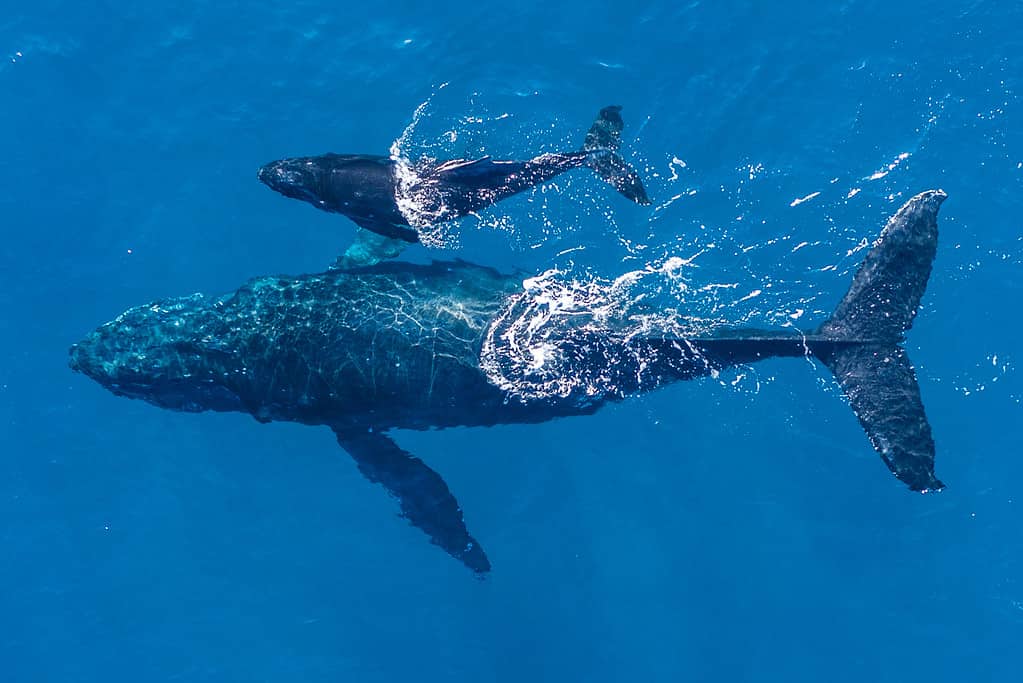
Humpback whales are found in Maine.
©Justin Berken/Shutterstock.com
2. Pilot Whales
Another kind of whale you may find off the coast of Maine is the pilot whale. They are one of the most common whale species in Maine and are best spotted during spring, summer, and fall. Pilot whales live in large pods. They are very social animals and live in pods of up to 30 whales, although larger pods have been recorded. During low tides, sometimes these whales get stuck in Maine.
Pilot whales are members of the Delphinidae family. There are two types of pilot whales, the long-finned pilot whale, and the short-finned pilot whale. There are a few distinct differences between both. Pilot whales are large and smooth whales with grey, brown, or black bodies and light markings. They also have an easy-to-spot marking on their bellies. Pilot whales are about 18 to 22 feet long. Short-finned pilot whales are larger. You can find pilot whales just about anywhere. They’ve been recorded near South Africa, the United States, Morocco, Argentina, and New Zealand.

Pilot whales are social animals that live in pods of up to 30 whales.
©Andrew Sutton/Shutterstock.com
3. Minke Whales
The next whale in Maine on our list is the minke whale. Minke whales are unique and massive baleen whales. There are two types of minke whales, the common minke whale, and the Antarctic minke whale. While minke whales are large, they are the second smallest baleen whale. They are about 27 to 29 feet long. Female minke whales are slightly larger than males.
Minke whales also weigh about 7.7 to 9.09 short tons. They are smooth, grey-purple, and black whales. They also have a white band on their flippers, which helps whale watchers tell them apart from other baleen whales. Minke whales also live for a long time. Their average lifespan is between 30 to 50 years. Minke whales are excellent swimmers and deep divers. They can reach impressive speeds of up to 24 mph. Minke whales only have one true natural predator, the killer whale. Orca whales (killer whales) are excellent hunters. They mainly target minke whale tongues and lower jaws.

Minke whales are excellent swimmers and divers. They can swim at speeds up to 24 mph.
©Annie Leblanc/Shutterstock.com
4. Finback Whales
Finback whales, also known as fin whales, are also found in Maine. Previously these long and slender whales were called razorback whales. Sadly, these amazing whales are listed as Vulnerable on the IUCN Red List. Finback whales are threatened by overhunting and accidental vehicle collision.
Finback whales are easily 60 feet long and can weigh as much as 69 tons. Interestingly, there is a size difference between finback whales in the Northern Hemisphere and those in the Southern Hemisphere. Although uncommon, the largest recorded finback whale in the North Atlantic measured 80 feet long. Finback whales, as their name suggests, are known for the fin on their backs. They are sometimes mistaken as dolphins because of this fin. Finback whales are brown or dark grey with white markings. Female fin whales have a long gestation period of 11 to 12 months. Young calves remain with their mother for about a year and are weened off when they reach around 36 feet long. These amazing animals also live long lives. They usually live up to 94 years, although some may live as much as 130 years.
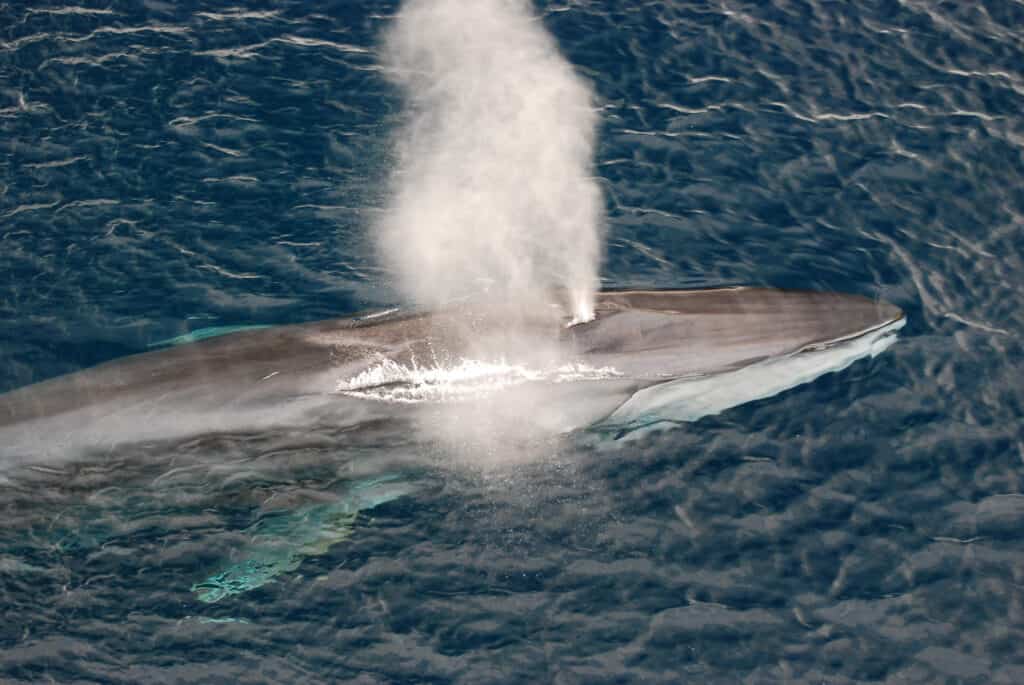
Finback whales are large animals that live long lives. They can live up to 94 years.
©iStock.com/JG1153
5. Sperm Whales
Although not as common as other whale species, you can also sometimes spot sperm whales off the coast of Maine. Sperm whale sightings are rare, but you may see one on a boat tour. But why are these whales rare? Sperm whales are listed as Vulnerable on the IUCN Red List. These large animals are the largest of the toothed whales. They are 36 to 52 feet long. Male sperm whales are three times larger than females. These males can easily weigh 50 short tons and sometimes more. If you think this is impressive, know that newborn sperm whales are 13 feet long and weigh 1.1 short tons.
Sperm whales have long and thick teeth. Each tooth weighs approximately 2.2 pounds. Interestingly, sperm whales have massive brains. They have the largest known brain in the animal world. Their brain weighs an average of 17 pounds. Although these animals have large brains, they have a lower encephalization quotient than dolphins and humans.

Sperm whales are born with big brains that can weigh between 14 and 20 pounds.
©Animalgraphy/Shutterstock.com
6. Sei Whales
While not as common as other whale species like the minke whale, sei whales are sometimes spotted in Maine during summer. In the summer, these baleen whales travel through the coast of Maine. Sei whales are large, and just like sperm whales, are rare to see. Sei whales are listed as Endangered on the IUCN Red List. There may be less than 80,000 sei whales left in the world. One of the biggest reasons for the population decline is large-scale commercial whaling. During the 19th and 20th centuries, this practice killed over 250,000 sei whales.
Sei whales are large animals. They measure about 64 feet long. These fast-swimming whales also eat a lot. In one day, they consume as much as 2,000 pounds of food. Sei whales are excellent filter feeders. They open their mouths wide and trap food. Sei whales communicate using sound and calls. They are known for producing long and low-frequency calls.
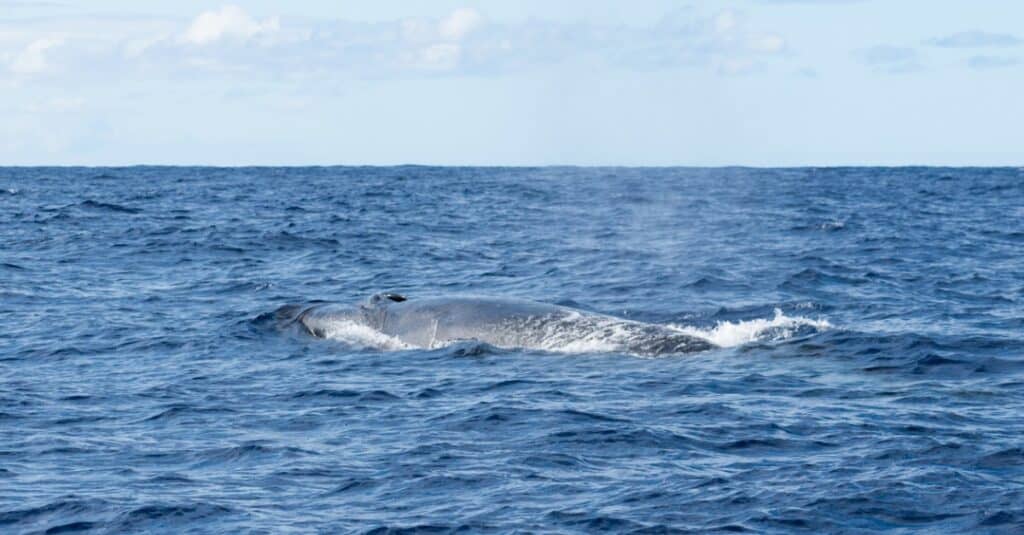
Sei whales are endangered.
©Rich Higgins/Shutterstock.com
7. Orca Whales
The last whale on our list you may find in Maine is the orca whale, also called the killer whale. Few orca whales find their way to the coast of Maine. It’s usually the same killer whale that is spotted in Maine’s waters. Old Thom is a male killer whale sometimes seen swimming alone in the Gulf of Maine and the Bay of Fundy. This loner orca has also been spotted swimming alongside Atlantic white-sided dolphins. While this orca may have traveled to Maine previously, the first recorded observation is from 2006.
Orca whales are rarely loners. Most killer whales live in large pods. Killer whales are large and highly intelligent animals. Despite their name, they are dolphins, not whales. Killer whales are about 20 to 30 feet long. Newborn orcas are almost 8 feet long.
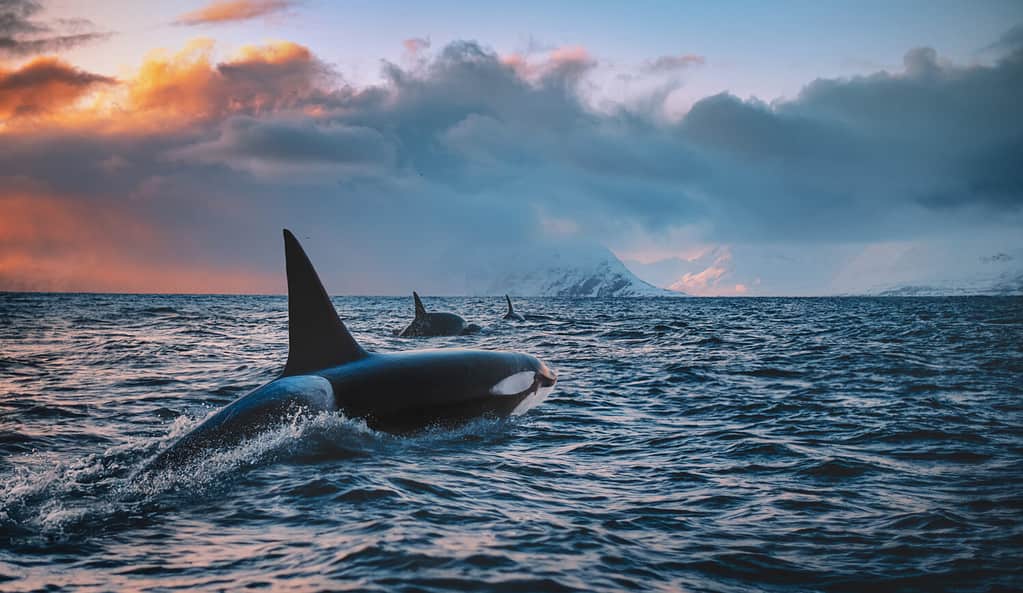
Killer whales are uncommon in Maine. The most commonly spotted orca off the coast of Maine is Old Thom, a loner orca.
©Willyam Bradberry/Shutterstock.com
Summary of 7 Types of Whales You’ll Find in Maine
| Whale | When to See Them | |
|---|---|---|
| 1 | Humpback Whales | Mid-April through October |
| 2 | Pilot Whales | Spring, Summer, and Fall |
| 3 | Minke Whales | Summer |
| 4 | Finback Whales | April through October |
| 5 | Sperm Whales | April through October |
| 6 | Sei Whales | April through October |
| 7 | Orca | April through October |
The photo featured at the top of this post is © Jay Yuan/Shutterstock.com
Thank you for reading! Have some feedback for us? Contact the AZ Animals editorial team.







